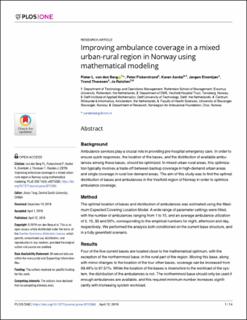| dc.contributor.author | van den Berg, Pieter L. | |
| dc.contributor.author | Fiskerstrand, Peter | |
| dc.contributor.author | Aardal, Karen | |
| dc.contributor.author | Einerkjær, Jørgen | |
| dc.contributor.author | Thoresen, Trond | |
| dc.contributor.author | Røislien, Jo | |
| dc.date.accessioned | 2021-07-01T11:06:47Z | |
| dc.date.available | 2021-07-01T11:06:47Z | |
| dc.date.created | 2019-04-16T09:33:37Z | |
| dc.date.issued | 2019-04 | |
| dc.identifier.citation | van den Berg, P.L., Fiskerstand, P., Aardal, K. et al. (2019) Improving ambulance coverage in a mixed urban-rural region in Norway using mathematical modeling. PLOS ONE, 14 (4), e0215385. | en_US |
| dc.identifier.issn | 1932-6203 | |
| dc.identifier.uri | https://hdl.handle.net/11250/2762778 | |
| dc.description.abstract | Background
Ambulance services play a crucial role in providing pre-hospital emergency care. In order to ensure quick responses, the location of the bases, and the distribution of available ambulances among these bases, should be optimized. In mixed urban-rural areas, this optimization typically involves a trade-off between backup coverage in high-demand urban areas and single coverage in rural low-demand areas. The aim of this study was to find the optimal distribution of bases and ambulances in the Vestfold region of Norway in order to optimize ambulance coverage.
Method
The optimal location of bases and distribution of ambulances was estimated using the Maximum Expected Covering Location Model. A wide range of parameter settings were fitted, with the number of ambulances ranging from 1 to 15, and an average ambulance utilization of 0, 15, 35 and 50%, corresponding to the empirical numbers for night, afternoon and day, respectively. We performed the analysis both conditioned on the current base structure, and in a fully greenfield scenario.
Results
Four of the five current bases are located close to the mathematical optimum, with the exception of the northernmost base, in the rural part of the region. Moving this base, along with minor changes to the location of the four other bases, coverage can be increased from 93.46% to 97.51%. While the location of the bases is insensitive to the workload of the system, the distribution of the ambulances is not. The northernmost base should only be used if enough ambulances are available, and this required minimum number increases significantly with increasing system workload.
Conclusion
As the load of the system increases, focus of the model shifts from providing single coverage in low-demand areas to backup coverage in high-demand areas. The classification rule for urban and rural areas significantly affects results and must be evaluated accordingly. | en_US |
| dc.language.iso | eng | en_US |
| dc.publisher | Public Library of Science (PLoS) | en_US |
| dc.rights | Navngivelse 4.0 Internasjonal | * |
| dc.rights.uri | http://creativecommons.org/licenses/by/4.0/deed.no | * |
| dc.subject | ambulanse | en_US |
| dc.subject | sykebil | en_US |
| dc.subject | pre-hospitale tjenester | en_US |
| dc.title | Improving ambulance coverage in a mixed urban-rural region in Norway using mathematical modeling | en_US |
| dc.type | Peer reviewed | en_US |
| dc.type | Journal article | en_US |
| dc.description.version | publishedVersion | en_US |
| dc.rights.holder | © 2019 van den Berg et al. | en_US |
| dc.subject.nsi | VDP::Medisinske Fag: 700 | en_US |
| dc.source.pagenumber | 14 | en_US |
| dc.source.volume | 14 | en_US |
| dc.source.journal | PLOS ONE | en_US |
| dc.source.issue | 4 | en_US |
| dc.identifier.doi | 10.1371/journal.pone.0215385 | |
| dc.identifier.cristin | 1692844 | |
| dc.source.articlenumber | e0215385 | en_US |
| cristin.ispublished | true | |
| cristin.fulltext | original | |
| cristin.fulltext | original | |
| cristin.qualitycode | 1 | |

